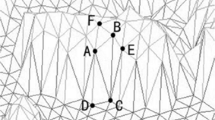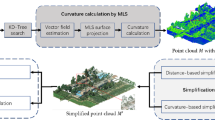Abstract
It is difficult to obtain digital elevation model (DEM) in the mountainous regions. As an emerging technology, Light Detection and Ranging (LiDAR) is an enabling technology. However, the amount of points obtained by LiDAR is huge. When processing LiDAR point cloud, huge data will lead to a rapid decline in data processing speed, so it is necessary to thin LiDAR point cloud. In this paper, a new terrain sampling rule had been built based on the integrated terrain complexity, and then based on the rule a LiDAR point cloud simplification method, which was referred as to TCthin, had been proposed. The TCthin method was evaluated by experiments in which XUthin and Lasthin were selected as the TCthin’s comparative methods. The TCthin’s simplification degree was estimated by the simplification rate value, and the TCthin’s simplification quality was evaluated by Root Mean Square Deviation. The experimental results show that the TCthin method can thin LiDAR point cloud effectively and improve the simplification quality, and at 5 m, 10 m, 30 m scale levels, the TCthin method has a good applicability in the areas with different terrain complexity. This study has theoretical and practical value in sampling theory, thinning LiDAR point cloud, building high-precision DEM and so on.



Similar content being viewed by others
References
Axelsson, P. (1999). Processing of laser scanner data—Algorithms and applications. ISPRS Journal of Photogrammetry and Remote Sensing, 54(2), 138–147.
Campbell, J. B., & Wynne, R. H. (2011). Introduction to remote sensing. New York City: Guilford Press.
Carter, J., Schmid, K., Waters, K., Betzhold, L., Hadley, B., Mataosky, R., et al. (2012). Lidar 101: An introduction to lidar technology, data, and applications. Charleston, SC: National Oceanic and Atmospheric Administration (NOAA) Coastal Services Center.
Cracknell, A. P. (2007). Introduction to remote sensing. Boca Raton: CRC Press.
Dong, Y. F., & Tang, G. A. (2013). Research on terrain simplification using terrain significance information index from digital elevation models. Geomatics and Information Science of Wuhan University, 38(3), 353–357.
Du, X. H. (2012). Memoryless iterative point cloud simplification algorithm. Computer Engineering and Applications, 48(3), 182–184.
Du, X. H., Yin, B. C., & Kong, D. H. (2007). Triangle mesh simplification algorithm based on edge collapse. Computer Engineering, 33(12), 12–15.
Fan, R., & Jin, X. G. (2013). Selection and reduction algorithms for large point clouds. Journal of Graphics, 34(3), 12–19.
Flood, M. (2001). Laser altimetry: From science to commerical LiDAR mapping. Photogrammetric Engineering and Remote Sensing, 67(11), 1209–1211.
Huang, W. M., Xiao, Z. X., Wen, P. Z., & Wu, X. J. (2010). Point cloud simplification with boundary points reservation: Point cloud simplification with boundary points reservation. Journal of Computer Applications, 30(2), 348–357.
Huang, Z. C., Zhang, Q. N., Xu, Z., Hong, A. D., & Zhang, R. F. (2017). The DEM grid aggregation based on the principal component transform model and its uncertainty analysis. Acta Geodaetica et Cartographica Sinica, 46(3), 389–397.
Krige, D. (1966). Two-dimensional weighted moving average trend surfaces for ore-evaluation. Journal of the South African Institute of Mining and Metallurgy, 66, 13–38.
Lee, P. F., & Jong, B. S. (2008). Point-based simplification algorithm. Wseas Transactions on Computer Research, 3(1), 61–66.
Li, H. B., Liu, Y. S., Yu, W. U., & Luo, X. (2013). Simplification algorithm for large mesh models based on quadric error metrics. Computer Engineering & Design, 34(9), 3158–3162.
Li, Y. C., & Pang, M. Y. (2012). Decimating point cloud based on quadric error metric. Journal of Chinese Computer Systems, 33(11), 2538–2542.
Li, D. J., Yin, F., & Sun, L. (2012). Research on compression of point cloud based on feature points. Bulletin of Surveying & Mapping, 27(1), 39–41.
Lim, S., Thatcher, C. A., Brock, J. C., Kimbrow, D. R., Danielson, J. J., & Reynolds, B. (2013). Accuracy assessment of a mobile terrestrial lidar survey at Padre Island National Seashore. International Journal of Remote Sensing, 34(18), 6355–6366.
Lu, H. X. (2008). Modelling terrain complexity. Berlin: Springer.
Lu, H. X., Liu, X. J., & Tang, G. A. (2012). Terrain complexity assessment based on multivariate analysis. Journal of Mountain Science, 30(5), 616–621.
Meng, X. L., Currit, N., & Zhao, K. G. (2010). Ground filtering algorithms for airborne LiDAR data: A review of critical issues. Remote Sensing, 2(3), 833–860.
Moenning, C., & Dodgson, N. A. (2004). Intrinsic point cloud simplification. In Proceedings of 14th GrahiCon, 6–10 Sept 2006, Moscow (Vol. 23).
Pauly, M., & Gross, M. (2001). Spectral processing of point-sampled geometry. In Proceedings of the 28th annual conference on computer graphics and interactive techniques (pp. 379–386).
Pauly, M., Gross, M., & Kobbelt, L. P. (2002). Efficient simplification of point-sampled surfaces. Proceedings of the conference on Visualization’02 (pp. 163–170).
Pauly, M., Mitra, N. J., & Guibas, L. J. (2004). Uncertainty and variability in point cloud surface data. SPBG, 4, 77–84.
Shi, B. Q., Liang, J., & Liu, Q. (2011). Adaptive simplification of point cloud using k k mathContainer Loading Mathjax -means clustering. Computer-Aided Design, 43(8), 910–922.
Song, H., & Feng, H. Y. (2009). A progressive point cloud simplification algorithm with preserved sharp edge data. The International Journal of Advanced Manufacturing Technology, 45(5), 583–592.
Sun, D. Z., Zhu, C. Z., Li, Y. R., & Liu, J. (2009). Accelerating algorithm for 3D convex hull construction of scattered data. Machine Design & Research, 25(4), 11–13.
Vosselman, G. (2000). Slope based filtering of laser altimetry data. International Archives of Photogrammetry and Remote Sensing, 33(B3/2; part 3), 935–942.
Xiao, Z. X., & Huang, W. M. (2009). Kd-tree based nonuniform simplification of 3D point cloud. In 3rd International conference on genetic and evolutionary computing (pp. 339–342).
Xu, J. Z., Wan, Y., & Zhang, S. (2008). On simplication method for lidar ground points cloud. Journal of Geomatics, 33(1), 32–34.
Zhang, K. Q., Chen, S. C., Whitman, D., Shyu, M. L., Yan, J., & Zhang, C. (2003). A progressive morphological filter for removing nonground measurements from airborne LIDAR data. IEEE Transactions on Geoscience and Remote Sensing, 41(4), 872–882.
Zhang, Q. N., Huang, Z. C., Shang, H. B., Hong, A. D., & Xu, Z. (2015). A simplified method based on terrain complexity for lidar point cloud and its uncertainty analysis. In International conference on intelligent earth observing and applications.
Zhang, Q. N., Huang, Z. C., Xu, Z., Hong, A. D., & Zhang, R. F. (2017). An adaptive weighting terrain complexity model. Mountain Research, 35(2), 230–237.
Zhang, K. Q., & Whitman, D. (2005). Comparison of three algorithms for filtering airborne lidar data. Photogrammetric Engineering & Remote Sensing, 71(3), 313–324.
Zhao, P. C., Wang, Y., & Hu, Q. W. (2016). A feature preserving algorithm for point cloud simplification based on hierarchical clustering. In 2016 IEEE international geoscience and remote sensing symposium (IGARSS) (pp. 5581–5584).
Zhou, L., Lin, H., Zhong, Y. X., & Yuan, C. L. (2004). The thinning method for measured points cloud in surface reconstruction. Mie of China, 5, 035.
Zhou, Q. M., Liu, X. J., & Sun, Y. Z. (2006a). Terrain complexity and uncertainties in grid-based digital terrain analysis. International Journal of Geographical Information Science, 20(10), 1137–1147.
Zhou, F., Zou, H. R., Liu, Z. B., & Ju, L. Y. (2006b). Point cloud data reduction in reverse engineering. Mechanical Engineer, 11, 84–85.
Acknowledgements
This research is supported by the Mapping Geographic Information Public Service Industry Research and Special Funds under Grant No. 201512028); the Central universities fundamental research funds under Grant No. 2682014CX017. The International Water Management Institute (IWMI) and the OpenTopography Facility of San Diego Supercomputer Center provide the remote sensing data.
Author information
Authors and Affiliations
Corresponding author
Ethics declarations
Conflict of interest
The authors declare that they have no conflict of interest.
About this article
Cite this article
Zhang, Qn., Huang, Zc., Xu, Z. et al. Study on Sampling Rule and Simplification of LiDAR Point Cloud Based on Terrain Complexity. J Indian Soc Remote Sens 46, 1773–1784 (2018). https://doi.org/10.1007/s12524-018-0831-x
Received:
Accepted:
Published:
Issue Date:
DOI: https://doi.org/10.1007/s12524-018-0831-x




